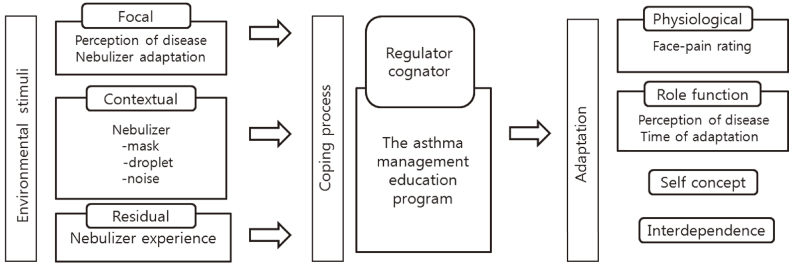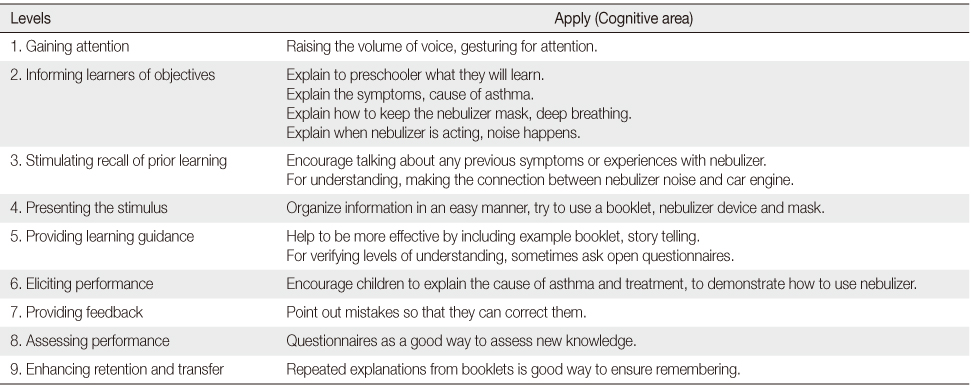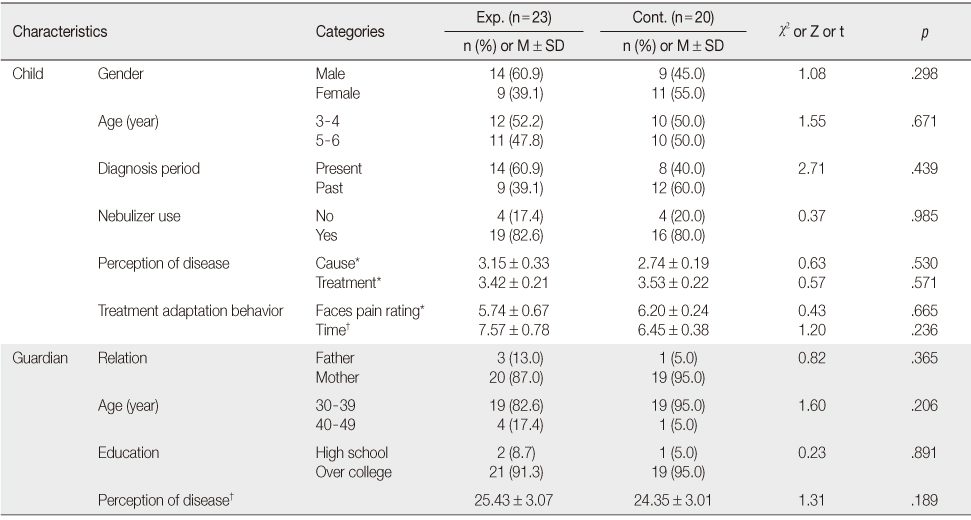Articles
- Page Path
- HOME > J Korean Acad Nurs > Volume 44(2); 2014 > Article
-
Original Article
- The Effects of an Asthma Management Education Program for Preschoolers
- Soyoun Yim
-
Journal of Korean Academy of Nursing 2014;44(2):189-197.
DOI: https://doi.org/10.4040/jkan.2014.44.2.189
Published online: April 30, 2014
Department of Nursing Science, The Baekseok University, Cheonan, Korea.
- Address reprint requests to: Yim, Soyoun. Department of Nursing Science, The Baekseok University, 76 Munam-ro, Dongnam-gu, Cheonan 330-704, Korea. Tel: +82-41-550-0722, Fax: +82-41-550-2829, ysybest@bu.ac.kr
© 2014 Korean Society of Nursing Science
This is an Open Access article distributed under the terms of the Creative Commons Attribution NoDerivs License. (http://creativecommons.org/licenses/by-nd/4.0/) If the original work is properly cited and retained without any modification or reproduction, it can be used and re-distributed in any format and medium.
Abstract
-
Purpose
- This study was conducted to develop an asthma management education program for preschool children using Roy's adaptation theory as a framework and examining the effects of this program on adaptation to asthma treatment.
-
Methods
- A non-equivalent control group pre-post-test design was used with 43 preschool children diagnosed with asthma and required to be hospitalized for inhalation therapy. An intervention group (n=23) participated in the educational program and a control group (n=20) received regular treatment. The education program was conducted and evaluated from June 30 to October 31 2012, a maximum 3 times every 24 hours during hospitalization. Two nurses conducted the program using the teaching method of Gagné and Briggs; instruction design theory through questionnaires to measure perception of disease, behavior of adaptation to treatment with inhalation therapy.
-
Results
- Effects of asthma management education program; scores for face-pain rating decreased and time of adaptation to treatment increased significantly in the experimental group compared to the control group but no significant differences were found for perception of the disease's cause and treatment.
-
Conclusion
- Results indicate that the asthma management education program has positive effects on adaptation to asthma treatment of preschoolers.
This manuscript is a condensed form of the first author's doctoral dissertation from The Ewha Womans University of Korea.
- 1. Tai A, Volkmer R, Burton A. Association between asthma symptoms and obesity in preschool (4-5 year old) children. J Asthma. 2009;46(4):362–365. http://dx.doi.org/10.1080/02770900902759260ArticlePubMed
- 2. Korea Centers for Disease Control and Prevention. The 5th Korea youth risk behavior web-based survey. Cheongwon: Korea Centers for Disease Control and Prevention; 2009.
- 3. Peterson MG, Gaeta TJ, Birkhahn RH, Fernández JL, Mancuso CA. History of symptom triggers in patients presenting to the emergency department for asthma. J Asthma. 2012;49(6):629–636. http://dx.doi.org/10.3109/02770903.2012.690480ArticlePubMedPMC
- 4. Ha YS, Lee JH, Kim HS, Park YA, Moon SY, Kim SJ, et al. Child health Nursing. 3rd ed. Seoul: Shinkwang Pub; 2012.
- 5. Berkowitz CD. Berkowitz's pediatrics: A primary care approach. 4th ed. Washington, DC: American Academy of Pediatrics; 2011.
- 6. Bayer JK, Sanson AV, Hemphill SA. Children's moods, fears, and worries: Development of an early childhood parent questionnaire. J Emot Behav Disord. 2006;14(1):41–49. http://dx.doi.org/10.1177/10634266060140010401
- 7. Perrin EC, Gerrity PS. There's a demon in your belly: Children's understanding of illness. Pediatrics. 1981;67(6):841–849.ArticlePubMedPDF
- 8. Bibace R, Walsh ME. Development of children's concepts of illness. Pediatrics. 1980;66(6):912–917.ArticlePubMedPDF
- 9. Brown R, Kulik J. Flashbulb memories. Cognition. 1977;5(1):73–99. http://dx.doi.org/10.1016/0010-0277(77)90018-XArticle
- 10. McQuaid EL, Howard K, Kopel SJ, Rosenblum K, Bibace R. Developmental concepts of asthma: Reasoning about illness and strategies for prevention. J Appl Dev Psychol. 2002;23(2):179–194. http://dx.doi.org/10.1016/S0193-3973(02)00103-X
- 11. Ahn HS, Hong CE. Pediatrics. 10th ed. Seoul: Mirae N Co. Ltd; 2012.
- 12. Roy SC, Andrews HA. Lee KS Kim CG Sung MS Lee MO Jang HJ Jeong GH . Roy adaptation model. 2nd ed. Stamford, CT: Appleton & Lange; 1999.
- 13. Gagné RM, Briggs LJ. Principles of instructional design. 2nd ed. New York, NY: Rinehart & Winston; 1979.
- 14. Byun YK. Teaching-learnig method. 2nd ed. Seoul: Hakjisa Publisher; 2005.
- 15. Gagné RM, Briggs LJ, Wager WW. Principles of instructional design. 4th ed. New York, NY: Harcourt Brace Jovanovich College Publishers; 1992.
- 16. Oh J. The development of a program promoting the adjustment and its effectiveness for school aged children's hospital life. J Korean Acad Nurs. 2004;34(3):525–533.ArticlePDF
- 17. Kim IO. A study on health education program development of respiratory communicable disease prevention for preschool children and the measurement of it's effects. Korean J Child Health Nurs. 2004;10(1):66–79.
- 18. Sung MH. A study on health/illness concepts in hospitalized preschoolers. Korean J Child Health Nurs. 2000;6(3):291–304.
- 19. Vacik HW, Nagy MC, Jessee PO. Children's understanding of illness: Students' assessments. J Pediatr Nurs. 2001;16(6):429–437. http://dx.doi.org/10.1053/jpdn.2001.27883ArticlePubMed
- 20. Wong DL, Baker CM. Pain in children: Comparison of assessment scales. Pediatr Nurs. 1988;14(1):9–17.PubMed
- 21. Oh KJ, Pae DH. Recognition of emotional expression and psychosocial adjustment of children and adolescents. Korean J Clin Psychol. 2002;21(3):515–532.
- 22. James SR, Ashwill JW. Song J Cho KJ Park ES Kim M Park HR Shin HS . Nursing care of children: Principles and practice. 3rd ed. St Louis, MO: Elsevier Health Sciences; 2007.
- 23. Hennessy-Harstad EB. Empowering adolescents with asthma to take control through adaptation. J Pediatr Health Care. 1999;13(6 Pt 1):273–277.PubMed
- 24. Kim SR, Yuk GL. Joint picture book interaction in mother-child dyads and children's linguistic expression. Korea J Child Care Educ. 2007;50:73–94.
- 25. Garra G, Singer AJ, Taira BR, Chohan J, Cardoz H, Chisena E, et al. Validation of the Wong-Baker FACES pain rating scale in pediatric emergency department patients. Acad Emerg Med. 2010;17(1):50–54. http://dx.doi.org/10.1111/j.1553-2712.2009.00620.xArticlePubMed
- 26. Yu H, Liu Y, Li S, Ma X. Effects of music on anxiety and pain in children with cerebral palsy receiving acupuncture: A randomized controlled trial. Int J Nurs Stud. 2009;46(11):1423–1430. http://dx.doi.org/10.1016/j.ijnurstu.2009.05.007ArticlePubMed
- 27. Kim MJ, Bae JH, Seo WS, Kim MY, Park SK, S PJ. An intervention study of pain reduction during IV therapy in hospitalized children. J Korean Soc Qual Assur Health Care. 2005;12(1):92–102.
- 28. Park MJ, Song YS, Kim YJ. The influences of meditation program using picture books on self-regulation and aggression of young children. J Child Educ. 2010;19(4):149–162.
- 29. Kim TR, Cho H, Rhee S, Bang HJ, Cho SJ, Cho SW, et al. Developmental psychology. Seoul: Hakjisa Publisher; 2004.
REFERENCES
Figure & Data
REFERENCES
Citations

- Environmental management education using immersive virtual reality in asthmatic children
Seung Hyun Kim, Sang Hyun Park, Insoon Kang, Yuyoung Song, Jaehoon Lim, Wonsuck Yoon, Young Yoo
Allergy, Asthma & Respiratory Disease.2022; 10(1): 33. CrossRef - Environmental management education using immersive virtual reality in asthmatic children in Korea: a randomized controlled study (secondary publication)
Seung Hyun Kim, Sang Hyun Park, Insoon Kang, Yuyoung Song, Jaehoon Lim, Wonsuck Yoon, Young Yoo
Journal of Educational Evaluation for Health Professions.2022; 19: 15. CrossRef - Knowledge and Practice in Self-Management on Asthma of School-Aged Children with Asthma
Seon Su Kim, In Soo Kwon
Child Health Nursing Research.2016; 22(2): 87. CrossRef - Educational Programs for the Management of Childhood Atopic Dermatitis: An Integrative Review
Yunmi Lee, Jina Oh
Asian Nursing Research.2015; 9(3): 185. CrossRef

Figure 1
Gagné and Briggs's Nine Levels of Learning Steps
General Characteristics and Homogeneity of Experimental and Control Groups (N=43)
*Wilcoxon rank-sum test; †independent t-test; Exp.=Experimental group; Cont.=Control group.
Comparison between Experimental Group and Control Group for Perception of Disease, Treatment-Adaptation Behavior (N=43)
Adm.=Admission; Exp.=Experimental group (n=23); Cont.=Control group (n=20).
*Wilcoxon rank-sum test; †independent t-test; Exp.=Experimental group; Cont.=Control group.
Adm.=Admission; Exp.=Experimental group (n=23); Cont.=Control group (n=20).
 KSNS
KSNS
 E-SUBMISSION
E-SUBMISSION




 Cite
Cite

